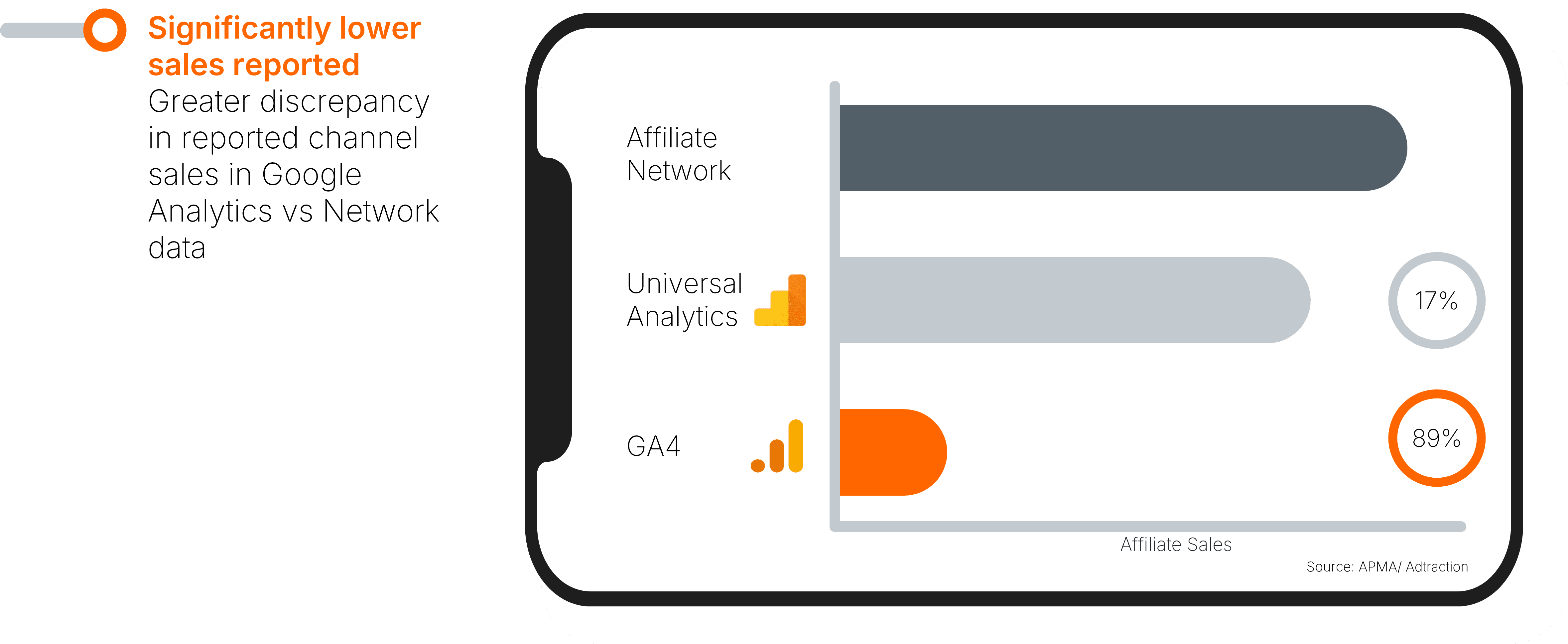Google Analytics 4 (GA4) – what is causing affiliate data to look so different and what can you do to manage this?
Written by Gareth Powell on 8 minute read
Awin’s Global Head of Customer Success, Gareth Powell, explores how GA4, may impact your ability to effectively measure affiliate activity.

The release of GA4 has brought a host of changes that have impacted the way that affiliate channel performance is reported and analyzed.
These changes are causing affiliate marketers to see a considerable drop in performance when viewing channel performance in Google Analytics.
The key changes impacting the way affiliate performance is reported within GA4 are:
- Greater reliance on GTM and UTM parameters
- A new methodology for defining Sessions
- A data-driven attribution model applied by default
This article will cover these changes in more detail to help affiliate marketers better understand why they are causing such differences in reporting. We’ll explore the potential impact this is having on channel performance, and explain what you can do to harness all available data to drive program growth and optimizations.
Greater reliance on Google Tag Manager (GTM) and UTM parameters
In order for GA4 to accurately measure traffic from any source to your website, it is required to be fully integrated via the container tag in Google Tag Manager (GTM). Without this being completed, all data from any traffic source to your website could be recorded incorrectly, making it impossible to optimize any marketing activity.
Specifically where affiliate marketing is concerned, GA4 also has a requirement to include the correct UTM parameters in all affiliate traffic. To do this you must ensure that all affiliate clicks contain the parameter utm_medium=affiliate.
If this is not done, the traffic and sales will be credited to other channels or simply track as (not set).
New methodology for defining Sessions
Arguably the biggest change to negatively impact the affiliate channel with GA4 is the new way that sessions are defined in comparison to Universal Analytics (UA).

With UA, any time a customer re-entered a website from a distinct marketing channel, this was defined as an event and importantly, a new session. However, with GA4, while this is still considered an event, multiple events can be contained within the same session.
Applying either UA’s ‘Last non-direct touch’ model or GA4’s equivalent ‘Paid and Organic Last Click Attribution’ model, it is critical that with both, the last session in the customer journey is credited with the sale and revenue.
The consequence of this new change to the way a session is defined means that often within GA4, the last affiliate touchpoint isn’t deemed the last session, so the prior click from a paid or organic channel is awarded the sale.
The result of this is that many affiliate managers are noticing considerable under-reporting of publishers in GA4, particularly publishers who deliver via last touch, such as incentive affiliates.
A data-driven attribution model by default
In UA, the default model for awarding sales and revenue was ‘Last non-direct touch’. This meant the last click aside from a direct click to the site was credited with 100% of the sale and revenue.
GA4 has changed this model to be a data-driven attribution model by default. This differs considerably from UA in that now all marketing touchpoints involved in the customer journey are credited with a portion of the sale and revenue, with Google’s algorithm determining how much credit is assigned to each respective touchpoint.
 This change benefits some publishers but negatively impacts others. Those appearing further up the funnel now receive credit where previously they wouldn’t, but those appearing in the last click now share some of the sale and revenue where previously they would have received full credit. As such, an affiliate program with a heavy weighting towards the lower funnel, will now see lower channel revenue overall.
This change benefits some publishers but negatively impacts others. Those appearing further up the funnel now receive credit where previously they wouldn’t, but those appearing in the last click now share some of the sale and revenue where previously they would have received full credit. As such, an affiliate program with a heavy weighting towards the lower funnel, will now see lower channel revenue overall.
While the move to an attribution model is typically seen as a fairer, more accurate way of awarding marketing contribution credit (and aligns with our ethos at Awin, having recently launched our own reports powered by attribution data), the proprietary, data-driven model applied by Google does represent somewhat of a ‘black-box’ in allocating how much of the sale and revenue is attributed to each marketing touchpoint.
The data points utilized by Google to power its model are:
- Time from conversion
- Device type
- Number of ad interactions
- The order of ad exposure
- The type of creative assets
Some of these data points will only be available to GA4 from sources from within the Google advertising network. This highlights that while GA4 provides accurate and sound tracking for Google owned channels, it has limited capabilities to accurately measure channels outside of its own ecosystem, including affiliate.
Impact on reported performance
The changes outlined in this article have caused a significant drop in reported performance for the affiliate channel in GA4. Our industry body the APMA, recently published some data from another network, Adtraction which looked at how affiliate performance was reported for the same period across three different reporting tools.

While there will always be a difference in reporting across any two given platforms, even if the logic is the same, the difference between GA4 and network reported numbers are drastically lower. Where UA reported 17% less sales than the network, GA4 reported 89% less sales over the same period.
What steps should you take?
It’s important to remember that Awin’s tracking remains robust and trustworthy, and GA4 is simply a different interpretation of data, one that focuses heavily on the performance from the Google advertising network.
Our four top tips are:
- Tech Setup – Check with your technical teams that GTM is configured correctly using the built-in debugger to GA4. If you notice any publishers in particular showing a significant drop-off in GA4, then check their links to ensure they are using the correct UTM parameter.
- Validations – As outlined by the changes to Session definition, the way that affiliate sessions are missed, especially at last touch mean that you should avoid using GA4 to validate sales. Instead, set up de-duplication in your Awin settings and use your internal reporting to confirm order statuses. Not only is this more robust, but should save you a lot of time too.
- Awin Tools – Where possible we would recommend you make use of Awin’s recently launched tools that are powered by attribution technology. Tools such as the Funnel report and Publisher Incrementality tool can give you a true view of the role your publishers are playing across the conversion path and help better understand true publisher value.
- Revert the view in GA4 – It is possible to view performance in a way that more closely aligns with that of UA. This can be done by heading to the ‘Advertising’ section, selecting ‘Attribution Models’ then adding ‘Last Click – Paid and Organic'.
Following these steps, and utilizing all available data sources you should be able to continue to drive affiliate program growth, and invest in the channel with confidence.
Awin’s Global Head of Customer Success, Gareth Powell, explains more about the impact GA4 may have on accurately measuring affiliate performance in the video below.
If you have any questions relating to GA4 and its impact on affiliate attribution at Awin, please get in touch with the team.

